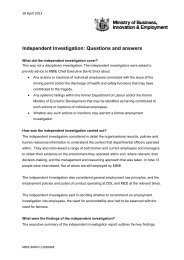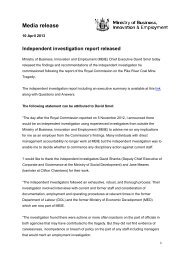Improving health and safety at work: An effective regulatory framework
Improving health and safety at work: An effective regulatory framework
Improving health and safety at work: An effective regulatory framework
Create successful ePaper yourself
Turn your PDF publications into a flip-book with our unique Google optimized e-Paper software.
In Confidenceexp<strong>and</strong> <strong>and</strong> strengthen protections from discrimin<strong>at</strong>ion for <strong>work</strong>ers (includingnon-employees) who raise <strong>health</strong> <strong>and</strong> <strong>safety</strong> issuesnot adopt requirements in the Model Law th<strong>at</strong> are neither necessary norappropri<strong>at</strong>e in the New Zeal<strong>and</strong> context, for example the Model Law’s provisionson <strong>work</strong>place <strong>health</strong> <strong>and</strong> <strong>safety</strong> entry permits7 <strong>An</strong>other key Taskforce recommend<strong>at</strong>ion was to improve the regul<strong>at</strong>ion of major hazardfacilities. Consistent with the Taskforce’s recommend<strong>at</strong>ions, I propose makingregul<strong>at</strong>ions to prevent <strong>and</strong> mitig<strong>at</strong>e the effects of major accidents <strong>at</strong> large chemicalproduction <strong>and</strong> storage facilities; downstream petroleum facilities (e.g. oil refineries);<strong>and</strong> other facilities (e.g. fertiliser plants) th<strong>at</strong> store or process very large quantities ofdangerous substances.8 In order to address uncertainty <strong>and</strong> regul<strong>at</strong>ory gaps, regul<strong>at</strong>ions, guidance <strong>and</strong> ACOPswill need to be developed to provide duty-holders <strong>and</strong> <strong>work</strong>ers with certainty about howthe law <strong>and</strong> regul<strong>at</strong>ions will apply to them, without being unnecessarily prescriptive.This will not only promote better <strong>health</strong> <strong>and</strong> <strong>safety</strong> outcomes, but will make complianceeasier for businesses.Background9 New Zeal<strong>and</strong>’s primary <strong>work</strong>place <strong>health</strong> <strong>and</strong> <strong>safety</strong> legisl<strong>at</strong>ion, the Health <strong>and</strong> Safetyin Employment Act 1992 (HSE Act), follows a model commonly known as the Robensapproach 1 .10 The Robens approach seeks to increase awareness, knowledge <strong>and</strong> competence inmanaging <strong>work</strong>place <strong>health</strong> <strong>and</strong> <strong>safety</strong>, r<strong>at</strong>her than rely on prescriptive requirementsfocusing on a narrow range of <strong>work</strong>place hazards. Performance-based general dutiesensure broad coverage of <strong>work</strong> <strong>and</strong> <strong>work</strong>places. Advantages of the all-encompassingn<strong>at</strong>ure of these general duties are th<strong>at</strong> they do not quickly d<strong>at</strong>e, they support innov<strong>at</strong>ion<strong>and</strong> they provide flexibility. The duties are underpinned by industry- or hazard-specificregul<strong>at</strong>ions, approved codes of practice <strong>and</strong> guidance where further clarity is required.11 The Robens approach remains the preferred method for legisl<strong>at</strong>ing for <strong>work</strong>place<strong>health</strong> <strong>and</strong> <strong>safety</strong> across many Commonwealth jurisdictions. Australia <strong>and</strong> the UnitedKingdom have both confirmed their Robens-based models as the best approach afterrecent reviews of their legisl<strong>at</strong>ive systems.Duties Frame<strong>work</strong>Problem definition12 The HSE Act is now 20 years old. The Royal Commission on the Pike River Coal MineTragedy concluded th<strong>at</strong> our implement<strong>at</strong>ion of the Robens approach has beenincomplete – particularly in rel<strong>at</strong>ion to the rel<strong>at</strong>ive lack of regul<strong>at</strong>ions, Approved Codesof Practice (ACoPs) or guidance to make the HSE Act as <strong>effective</strong> as intended.13 Other problems identified in submissions to the Independent Taskforce on WorkplaceHealth <strong>and</strong> Safety <strong>and</strong> th<strong>at</strong> have been raised by business <strong>and</strong> stakeholders include:a. duty holders have difficulty knowing wh<strong>at</strong> to do in order to meet the generalduties – or knowing whether they have done enough to be considered compliant.This can result in duty holders not doing enough, or being over-cautious in theirinterpret<strong>at</strong>ion - <strong>effective</strong>ly increasing the compliance burden on themselves1 So named after its ‘f<strong>at</strong>her’, Lord Alfred Robens. His 1972 report to the British government, Safety <strong>and</strong> Health <strong>at</strong> Work,transformed the <strong>at</strong>titudes towards <strong>and</strong> organis<strong>at</strong>ion of occup<strong>at</strong>ional <strong>health</strong> <strong>and</strong> <strong>safety</strong>.MBIE-MAKO-146085572






![Questions and answers [367 KB PDF] - Ministry of Business ...](https://img.yumpu.com/38301946/1/184x260/questions-and-answers-367-kb-pdf-ministry-of-business-.jpg?quality=85)
![MBIE vs New Zealand Defence Force Summary of Fact [165 KB PDF]](https://img.yumpu.com/38246180/1/184x260/mbie-vs-new-zealand-defence-force-summary-of-fact-165-kb-pdf.jpg?quality=85)